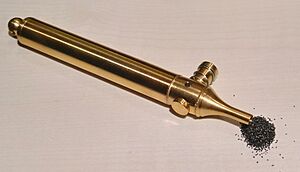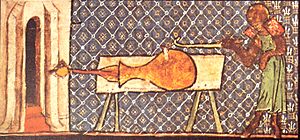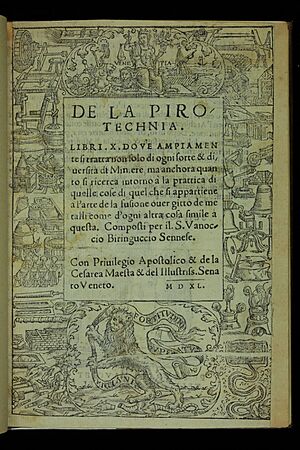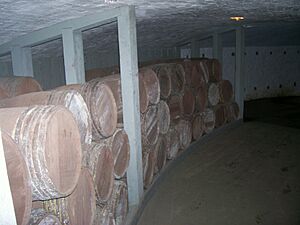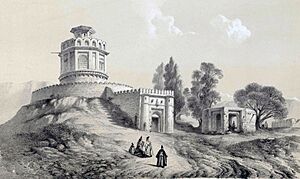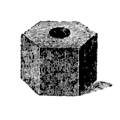Gunpowder facts for kids
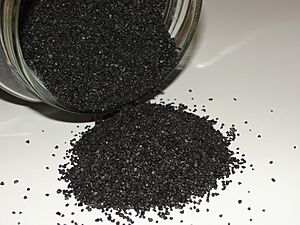
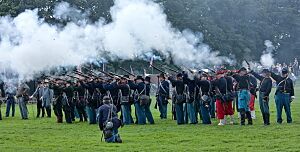
Gunpowder, also called black powder, is the oldest known chemical explosive. It's made from a mix of sulfur, charcoal (which is mostly carbon), and potassium nitrate (saltpeter). The sulfur and charcoal are like the fuel, and the saltpeter helps it burn by providing oxygen.
People have used gunpowder for many things. It's a propellant in firearms (like guns), artillery (big cannons), rockets, and pyrotechnics (fireworks). It was also used for blasting rocks in quarrying, mining, and building tunnels and roads.
Gunpowder is a "low explosive." This means it burns quickly but doesn't explode with a huge shockwave like modern explosives. When gunpowder burns behind a projectile (like a bullet), it creates enough pressure to push the shot out of the gun barrel very fast. It's good for pushing things, but not as strong for shattering hard rock. Still, it was used in mining and civil engineering until the late 1800s.
Gunpowder is one of the Four Great Inventions from China. It was first made by Taoists for medicine. Then, around AD 904, it was used in wars. Today, newer explosives like smokeless powder have mostly replaced it in weapons. For industrial uses, things like dynamite are much more powerful.
Contents
How Gunpowder Works
Gunpowder is a low explosive. It doesn't explode instantly (detonate). Instead, it deflagrates, which means it burns very fast. This is good for guns because it pushes the bullet without breaking the gun itself.
When gunpowder burns, it creates a lot of hot gas. If this gas is trapped, like inside a shell or a pipe bomb, the pressure builds up. This pressure can cause the container to burst, sending pieces flying.
In quarrying, where people cut stone, high explosives are usually better for breaking rock. But because gunpowder burns slower, it causes fewer cracks in the stone. This makes it useful for fragile stones like slate or large blocks of granite and marble.
Gunpowder is also used for blank rounds (shots that make noise but don't fire a bullet), signal flares, and in fireworks to launch shells into the sky. It's also used in special effects for movies and shows.
When gunpowder burns, less than half of it turns into gas. Most of it becomes tiny solid particles, like soot. This soot can make the air smoky and dirty the inside of gun barrels. It also makes it harder to see during battles. This residue is also hygroscopic, meaning it absorbs moisture from the air. When it mixes with water, it can become corrosive and damage gun barrels made of wrought iron or steel. Because of this, guns that use gunpowder need to be cleaned often and very well.
The History of Gunpowder
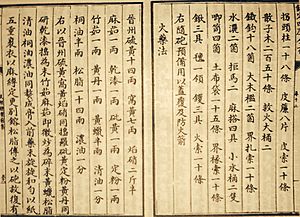
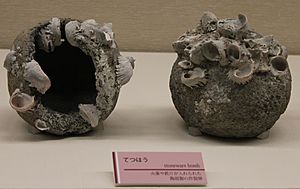
Gunpowder in China
The first clear mention of gunpowder in China was in the 9th century, during the Tang dynasty. It was found in old Daoist texts. These texts described how mixing sulfur, saltpeter, and honey could cause smoke and flames. It seems Chinese alchemists accidentally discovered gunpowder while trying to find a way to live forever! This is why its Chinese name, huoyao, means "fire medicine."
The earliest chemical recipe for gunpowder was written in the 11th century. It was in a book called Wujing Zongyao (Complete Essentials from the Military Classics). This book mentioned mixtures for fire arrows, fireworks, and rockets. The mixtures in this book were not strong enough to explode. They were more like incendiary devices, meaning they caused fires.
Gunpowder was first used in war in 904 AD, as fiery projectiles. Later, weapons like bombs, "fire lances" (early flamethrowers), and the first guns appeared in China. Explosive bombs have even been found in a shipwreck from 1281, from the time of the Mongol invasions of Japan.
By the 12th century, "fire lances" became common. These were tubes that shot flames. Later, they added projectiles to these fire lances. By the late 1200s, metal fire lances became "eruptors," which were early cannons. Soon after, they became true guns, like the hand cannon.
Gunpowder in the Middle East
Some historians believe the Mongols brought gunpowder to the Middle East. Muslims learned about gunpowder between 1240 and 1280. A Syrian writer named Hasan al-Rammah wrote recipes for gunpowder. He called saltpeter "Chinese snow" and rockets "Chinese arrows," suggesting the knowledge came from China.
Al-Rammah's book included many gunpowder recipes, especially for rockets. Some of these recipes were very similar to modern ideal mixes for rockets. His book also mentioned fuses, bombs, and even an early torpedo that could move and burn in water.
Some historians say that the Mamluk Sultanate used the first cannon in history against the Mongols in 1260. However, it's hard to be sure because old Arabic texts used the same word for gunpowder as they did for an older fiery liquid called naphtha. The first clear evidence of cannons in the Islamic world is from an Arabic manuscript from the early 1300s.
The musket (an early type of rifle) appeared in the Ottoman Empire by 1465. The Ottomans were very good at making gunpowder. This helped them expand their empire between the 1400s and 1700s.
Gunpowder in Europe
The first Western writings about gunpowder are from the English philosopher Roger Bacon in 1267. The oldest written recipes in Europe were found between 1280 and 1300 in a book called Liber Ignium (Book of Fires).
Some people think the Mongols might have brought gunpowder weapons to Europe during the Battle of Mohi in 1241. But there isn't strong proof that Mongols used gunpowder weapons often outside of China.
In England, gunpowder was being made at the Tower of London by 1346. During the late 1300s, Europeans made gunpowder better by "corning" it. This meant drying it into small clumps. This made it burn better and more consistently. They also learned to purify saltpeter more effectively.
During the Renaissance, people like Vannoccio Biringuccio in Italy wrote books about how to make fireworks and explosives. His book, De la pirotechnia (1540), shared knowledge that was usually kept secret.
In the late 1700s, Antoine Lavoisier, a French lawyer, was put in charge of gunpowder production in France. He improved how saltpeter was made and how gunpowder was manufactured. His work made French gunpowder the best in the world by 1788. This surplus of gunpowder was very helpful to the American Revolution.
In the late 1800s, smokeless powder was invented. This new powder was much more powerful and cleaner than black powder. Because of this, the gunpowder industry started to shrink. Most gunpowder factories in Britain closed down after World War I. The last gunpowder factory in Great Britain closed in 1976.
Gunpowder in India
Gunpowder and gunpowder weapons came to India through the Mongol invasions of India. By 1366, firearms called top-o-tufak were used in many Muslim kingdoms in India. From then on, gunpowder weapons were common in India.
The Ottoman Admiral Seydi Ali Reis introduced early matchlock weapons to India around 1531. After this, many different firearms, especially large guns, appeared in places like Tanjore and Dacca.
The Mughal Emperor Akbar made many matchlocks for his army. Later, Emperor Shah Jahan introduced even more advanced matchlocks. India, especially the regions of Gujarāt, Bengal, and Mālwa, supplied Europe with saltpeter for gunpowder in the 1600s.
The Sultanate of Mysore, led by Hyder Ali and his son Tipu Sultan, was the first in India to use modern cannons and muskets. They also famously used Mysorean rockets against the British during the Second Anglo-Mysore War. These rockets later inspired the British to develop the Congreve rocket.
Gunpowder in Southeast Asia
Cannons were brought to Majapahit when Kublai Khan's Chinese army tried to invade Java in 1293. Cannons were also used by the Ayutthaya Kingdom in 1352 during its invasion of the Khmer Empire. By the end of that century, firearms were used by the Trần dynasty as well.
Even though people in Java knew about gunpowder weapons after the Mongol invasion, "true" firearms came later, after the mid-1400s. These were likely brought by Arab traders. Before the Portuguese arrived, people in Southeast Asia already had simple firearms called the Java arquebus. When the Portuguese came, they influenced local weapons, leading to new types of firearms.
By the early 1500s, the Javanese were making large guns themselves. Some of these huge cannons, weighing tons, still exist today and are called "sacred cannons."
What Gunpowder is Made Of
Gunpowder is a mix of three main ingredients:
- Potassium nitrate (saltpeter)
- Sulfur
- Charcoal (carbon)
The exact amounts of each ingredient changed a lot over time. People figured out the best recipes through trial and error.
When gunpowder burns, it doesn't just make one thing. It creates many different products. Some are solid, like potassium carbonate and soot. Others are gases, like carbon dioxide and nitrogen.
Gunpowder doesn't release as much energy as modern explosives like TNT. This means you need a lot of gunpowder to get a strong push, especially for heavy projectiles.
How Gunpowder is Made
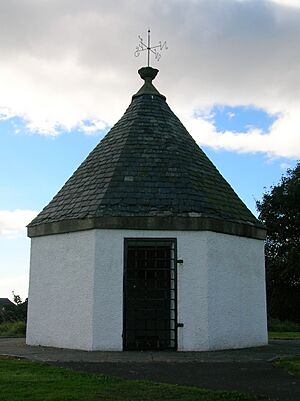
To make the strongest black powder, people use charcoal made from certain types of wood, like Pacific willow. The ingredients are ground into very fine particles and mixed together as closely as possible.
In the past, this was done with a mortar and pestle or by stamping. Later, they used rotating ball mills made of materials that wouldn't cause sparks, like bronze or lead. The mix was often dampened with alcohol or water while grinding. This helped prevent accidental fires and made sure the saltpeter mixed well with the charcoal.
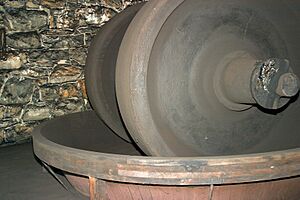
Around the late 1300s, European makers started adding liquid during grinding. This improved mixing and reduced dust, which lowered the risk of explosions. The damp gunpowder mixture, called "mill cake," was then shaped into small grains or "corns" and dried. Corned powder lasted longer and was more powerful and easier to load into guns.
Later, makers pressed the mill cake to make it even denser and harder, like slate. They would then break these hard slabs into granules and sort them by size. In the United States, Eleuthere Irenee du Pont, who learned from Lavoisier, tumbled the dried grains in rotating barrels. This rounded the edges and made the powder more durable during shipping.
Another improvement was making charcoal in special kilns, which allowed better control over the temperature. This helped make gunpowder more powerful and consistent. In 1863, chemists found a way to make potassium nitrate from cheaper sodium nitrate.
By the 1700s, gunpowder factories relied more and more on machines. However, controlling humidity during production was still a challenge, even in the late 1800s.
Other Uses for Gunpowder
Besides being used in guns and cannons, black powder was also very important for blasting in quarrying, mining, and building roads and railroads. In the 1800s, more black powder was used for these industrial jobs than for weapons, except during wars. Eventually, dynamite and other newer explosives replaced it for these uses.
Starting in the 1930s, gunpowder was used in tools like rivet guns and "stud guns." These tools could drive nails or screws into solid concrete, which was very useful in construction.
Gunpowder has also been used for some unusual things:
- After a battle in 1809, a French army surgeon used gunpowder to season horse meat broth for wounded soldiers when there was no salt.
- British sailors sometimes used gunpowder to make tattoos by rubbing it into pricked skin when they didn't have ink.
- In 1673, Christiaan Huygens tried to build an early gunpowder engine, but it didn't work well.
- In 1853, someone tried using black powder to crush gold-bearing ores by firing them from a cannon. This idea didn't catch on because better crushing machines were already being developed.
- Starting in 1967, artist Ed Ruscha used gunpowder as an art material for drawings.
Interestingly, gunpowder was originally made for medicine. People ate it for digestion, inhaled it for breathing problems, and rubbed it on skin issues like rashes.
Images for kids
-
Gunner of Nguyễn dynasty, Vietnam
See also
 In Spanish: Pólvora para niños
In Spanish: Pólvora para niños
- Ballistics
- Black powder rocket motor
- Black powder substitute
- Gunpowder magazine
- Gunpowder Plot
- Gunpowder warfare
- Technology of the Song dynasty


